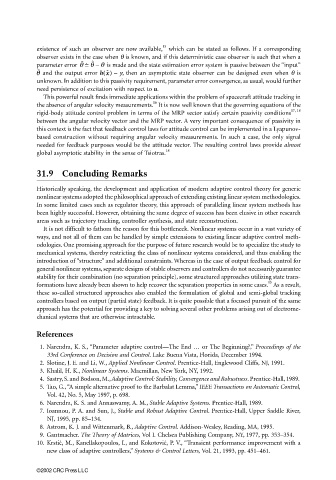Page 949 - The Mechatronics Handbook
P. 949
0066_frame_C31.fm Page 12 Friday, January 18, 2002 5:52 PM
15
existence of such an observer are now available, which can be stated as follows. If a corresponding
observer exists in the case when θ is known, and if this deterministic case observer is such that when a
˜
ˆ
parameter error θ = ˙ θ – θ is made and the state estimation error system is passive between the “input”
θ and the output error h x ˆ () − y, then an asymptotic state observer can be designed even when θ is
˜
unknown. In addition to this passivity requirement, parameter error convergence, as usual, would further
need persistence of excitation with respect to u.
This powerful result finds immediate applications within the problem of spacecraft attitude tracking in
16
the absence of angular velocity measurements. It is now well known that the governing equations of the
rigid-body attitude control problem in terms of the MRP vector satisfy certain passivity conditions 17, 18
between the angular velocity vector and the MRP vector. A very important consequence of passivity in
this context is the fact that feedback control laws for attitude control can be implemented in a Lyapunov-
based construction without requiring angular velocity measurements. In such a case, the only signal
needed for feedback purposes would be the attitude vector. The resulting control laws provide almost
global asymptotic stability in the sense of Tsiotras. 18
31.9 Concluding Remarks
Historically speaking, the development and application of modern adaptive control theory for generic
nonlinear systems adopted the philosophical approach of extending existing linear system methodologies.
In some limited cases such as regulator theory, this approach of paralleling linear system methods has
been highly successful. However, obtaining the same degree of success has been elusive in other research
areas such as trajectory tracking, controller synthesis, and state reconstruction.
It is not difficult to fathom the reason for this bottleneck. Nonlinear systems occur in a vast variety of
ways, and not all of them can be handled by simple extensions to existing linear adaptive control meth-
odologies. One promising approach for the purpose of future research would be to specialize the study to
mechanical systems, thereby restricting the class of nonlinear systems considered, and thus enabling the
introduction of “structure” and additional constraints. Whereas in the case of output feedback control for
general nonlinear systems, separate designs of stable observers and controllers do not necessarily guarantee
stability for their combination (no separation principle), some structured approaches utilizing state trans-
15
formations have already been shown to help recover the separation properties in some cases. As a result,
these so-called structured approaches also enabled the formulation of global and semi-global tracking
controllers based on output (partial state) feedback. It is quite possible that a focused pursuit of the same
approach has the potential for providing a key to solving several other problems arising out of electrome-
chanical systems that are otherwise intractable.
References
1. Narendra, K. S., “Parameter adaptive control—The End … or The Beginning?,” Proceedings of the
33rd Conference on Decision and Control. Lake Buena Vista, Florida, December 1994.
2. Slotine, J. E. and Li, W., Applied Nonlinear Control. Prentice-Hall, Englewood Cliffs, NJ, 1991.
3. Khalil, H. K., Nonlinear Systems. Macmillan, New York, NY, 1992.
4. Sastry, S. and Bodson, M., Adaptive Control: Stability, Convergence and Robustness. Prentice-Hall, 1989.
5. Tao, G., “A simple alternative proof to the Barbalat Lemma,” IEEE Transactions on Automatic Control,
Vol. 42, No. 5, May 1997, p. 698.
6. Narendra, K. S. and Annaswamy, A. M., Stable Adaptive Systems. Prentice-Hall, 1989.
7. Ioannou, P. A. and Sun, J., Stable and Robust Adaptive Control. Prentice-Hall, Upper Saddle River,
NJ, 1995, pp. 85–134.
8. Astrom, K. J. and Wittenmark, B., Adaptive Control. Addison-Wesley, Reading, MA, 1995.
9. Gantmacher. The Theory of Matrices, Vol I. Chelsea Publishing Company, NY, 1977, pp. 353–354.
c ´
c ´
10. Krsti , M., Kanellakopoulos, I., and Kokotovi , P. V., “Transient performance improvement with a
new class of adaptive controllers,” Systems & Control Letters, Vol. 21, 1993, pp. 451–461.
©2002 CRC Press LLC

